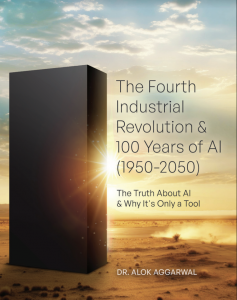New Book Explores Applications of Artificial Intelligence for Enhancing Blockchains
Researcher and innovator Alok Aggarwal’s new book explores the impact of the Fourth Industrial Revolution and how it will evolve in the coming decades
SAN JOSE, CALIFORNIA, USA, March 7, 2024 /EINPresswire.com/ -- The seventh chapter of Alok Aggarwal’s new book, "The Fourth Industrial Revolution & 100 Years of AI (1950-2050)” discusses how Blockchain serves as the bedrock of the fourth industrial revolution, offering transparent, immutable, and auditable transactions, and it also explores how Data Science and AI are improving this invention further to provide superior results.In 2008, the demise of the fourth-largest investment bank, Lehman Brothers, exposed the vulnerabilities of a system built on trust, plagued by corruption, fraud, and self-aggrandizement. The need for a decentralized financial system became glaringly apparent, paving the way for innovative solutions.
Coincidentally, in October 2008, just after Lehman Brothers' collapse, an anonymous author, Satoshi Nakamoto, introduced a groundbreaking research article titled "Bitcoin: A Peer-to-Peer Electronic Cash System." This marked the beginning of Blockchain technology, a decentralized system using a peer-to-peer network for financial transactions.
Key takeaways from this chapter include:
• Advantages of a decentralized system: An optimized decentralized system for financial and supply chain transactions has the following advantages – (a) disintermediation, (b) strengthening community inclusion, (c) immutability and auditability, (d) transparency, (e) potentially lower costs for transactions, (f) greater speed, and (g) lower friction, especially when compared to the current monolithic intermediaries.
• Blockchain provides many advantages: Blockchain, which was originally introduced by Sakamoto in the form of Bitcoin and then expanded by Buterin by including Smart Contracts, is being exploited for creating extremely versatile decentralized systems. Immutability of Blockchain arises from the use of cryptographic hash functions, which ensure that even if several participants in the Blockchain collude against others, their collusion will be easily detected.
• Combination of Blockchain, IoT, and AI are providing valuable results: Innovators are already using the combination of Blockchain and Artificial Intelligence for improving a plethora of use cases in several industries including those in health care, supply chain, utilities, banking, financial services, and insurance. Similarly, other innovators are combining Blockchain, AI, and Internet of Things (IoT) to improve scalability (i.e., bringing new devices online and removing older ones quickly), increasing trust with clients, and creating new business models.
• Contemporary crypto coins are unlikely to displace traditional currencies: The precursor of Blockchain was Bitcoin, which led to the creation of the cryptocurrency industry. Although the future of approximately 4,000 different kinds of crypto coins is unclear, governments of some countries in Asia, Africa, and the Middle East are experimenting with potentially introducing Central Bank Digital Currencies (CBDCs). Also, in 2021, El Salvador became the first country to adopt Bitcoin as a legal tender.
Overall, the book, “The Fourth Industrial Revolution & 100 Years of AI (1950-2050)” provides a concise yet comprehensive exploration of AI, covering its origins, evolutionary trajectory, and its potential ubiquity during the next 27 years. Beginning with an introduction to the fundamental concepts of AI, subsequent chapters delve into its transformative journey with an in-depth analysis of achievements of AI, with a special focus on the potential for job loss and gain. The latter portions of the book examine the limitations of AI, the pivotal role of data in enabling accurate AI systems, and the concept of "good" AI systems. It concludes by contemplating the future of AI, addressing the limitations of classical computing, and exploring alternative technologies (such as Quantum. Photonics, Graphene, and Neuromorphic computing) for ongoing advancements in the field. This book is now available in bookstores and online retailers in Kindle, paperback, and hard cover formats.
About the Author and Scry AI: Dr. Aggarwal is the founder, CEO, and Chief Data Scientist of Scry AI, which provides innovative AI-based products, solutions, and services to enterprises across the globe. Before starting Scry AI, he co-founded Evalueserve (www.evalueserve.com) which provides research and analytics services worldwide. He received his Ph. D. from Johns Hopkins University and worked at IBM’s T. J. Watson Research Center during 1984 and 2000. He has written more than 120 research articles and has been granted eight patents. Scry AI is a research and development company that uses AI and Data Science to help its clients in solving complex and extremely laborious problems. Scry AI has developed more than 60 proprietary AI-based models and algorithms which constitute its CognitiveBricks platform of innovative business solutions. Scry AI’s family of enterprise solutions include: Collatio (an Intelligent Document Processing factory with unparalleled accuracy for reconciling unstructured and structured data), Anomalia (for detecting anomalies and potential fraud), Concentio (for providing actionable insights using Internet of Things’ data), Vigilo (for predicting operational and marketing risks), and Data Flow Mapping (for extracting data lineage as data flows through disparate systems). For more information, please visit: www.scryai.com
Alok Aggarwal
Scry AI, Inc.
+1 914-980-4717
email us here
Visit us on social media:
Facebook
Twitter
LinkedIn
Instagram
YouTube
Legal Disclaimer:
EIN Presswire provides this news content "as is" without warranty of any kind. We do not accept any responsibility or liability for the accuracy, content, images, videos, licenses, completeness, legality, or reliability of the information contained in this article. If you have any complaints or copyright issues related to this article, kindly contact the author above.

